Continuation of the previous post The Starry Night of Saint-Rémy-de-Provence (1/2)
In September 2016 I went to the Saint-Paul-de-Mausole monastery, a masterpiece of Provençal Romanesque art built in the vicinity of the Gallo-Roman city Glanum, south of Saint-Rémy de Provence. Part of the building remains today a psychiatric institution. Van Gogh stayed there from May 8, 1889 to May 16, 1890. On the second floor, the room where he was interned has been reconstructed.

Through the window, facing east, we can see the landscape that Van Gogh could contemplate. Even if this landscape has been transformed for a little more than a century, one does not see the hills represented in his painting. In reality, there is the wall of the asylum’s park that encloses a field of wheat, which extends between the asylum and the wall. And there are no large cypress trees in sight, and even less the village of Saint-Rémy.
 In fact the small chain of Alpilles is in direction of the South. As for the village of Saint-Rémy and its church tower, which is quite far away in the northern direction, it is just as invisible from the window. We conclude that Van Gogh did not paint the terrestrial part of his Starry Night from what he saw from his window.
In fact the small chain of Alpilles is in direction of the South. As for the village of Saint-Rémy and its church tower, which is quite far away in the northern direction, it is just as invisible from the window. We conclude that Van Gogh did not paint the terrestrial part of his Starry Night from what he saw from his window.
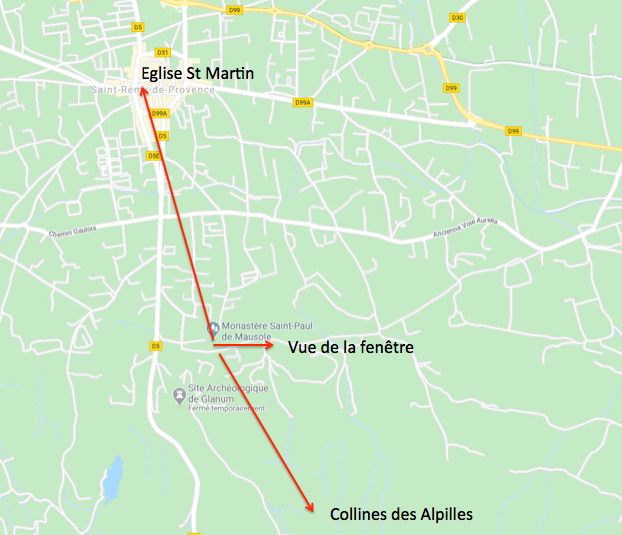 He must have gone outside. But when?
He must have gone outside. But when?
 My friend Philippe André, a psychiatrist and art lover who studied Van Gogh’s correspondence in depth before publishing his novel Moi, Van Gogh, artiste peintre in 2018, wrote to me that in the first days after his internment on May 8: “At night, he is locked in his room and his equipment is under lock and key in another empty room that he was kindly allocated for this purpose. Moreover, he was very distressed and only managed to paint his own works (Sunflowers, Joseph Roulin…) or to paint very similar elements that were in the park of the asylum (Iris, Lilacs…). No strength, during those first weeks, to paint deep landscapes! “
My friend Philippe André, a psychiatrist and art lover who studied Van Gogh’s correspondence in depth before publishing his novel Moi, Van Gogh, artiste peintre in 2018, wrote to me that in the first days after his internment on May 8: “At night, he is locked in his room and his equipment is under lock and key in another empty room that he was kindly allocated for this purpose. Moreover, he was very distressed and only managed to paint his own works (Sunflowers, Joseph Roulin…) or to paint very similar elements that were in the park of the asylum (Iris, Lilacs…). No strength, during those first weeks, to paint deep landscapes! “
In fact, when I was finally able to consult Van Gogh’s complete correspondence, I read that on May 9, the day after his arrival, he wrote to his sister-in-law “Jo” (Theo’s wife, therefore):
« Although there are a few people here who are seriously ill, the fear, the horror that I had of madness before has already been greatly softened.
And although one continually hears shouts and terrible howls as though of the animals in a menagerie, despite this the people here know each other very well, and help each other when they suffer crises. They all come to see when I’m working in the garden, and I can assure you are more discreet and more polite to leave me in peace than, for example, the good citizens of Arles.
It’s possible that I’ll stay here for quite a long time, never have I been so tranquil as here and at the hospital in Arles to be able to paint a little at last. Very near here there are some little grey or blue mountains, with very, very green wheatfields at their foot, and pines. » [Letter 772]
From the first sentence it is clear that his anxiety was perhaps not so great, and the rest of the letter confirms that he did begin to paint, but without being able to go beyond the confines of his room or the small garden.
On May 23, he wrote to his brother Theo:
« The landscape of St-Rémy is very beautiful, and little by little I’m probably going to make trips into it. But staying here as I am, the doctor has naturally been in a better position to see what was wrong, and will, I dare hope, be more reassured that he can let me paint.
[…] Through the iron-barred window I can make out a square of wheat in an enclosure, a perspective in the manner of Van Goyen, above which in the morning I see the sun rise in its glory. With this — as there are more than 30 empty rooms — I have another room in which to work. […] So this month I have 4 no. 30 canvases and two or three drawings. » [Letter 776]
This shows that Vincent plans to be able to walk in the countryside outside the monastery very soon. The four canvases he has in progress were painted in the garden.
Between May 31 and June 6 he wrote to Theo asking him to send him canvases, colors and brushes, his Arles supply being exhausted. He adds :
« This morning I saw the countryside from my window a long time before sunrise with nothing but the morning star, which looked very big. […] When I receive the new canvas and the colours I’ll go out a bit to see the countryside. » [Letter 777]
And finally, on June 9, after he had received the canvases and colors sent by Theo, whom he thanked warmly:
« I was very glad of it, for I was pining for work a little. Also, for a few days now I’ve been going outside to work in the neighbourhood. […]I have two landscapes on the go (no. 30 canvases) of views taken in the hills. […] Many things in the landscape here often recall Ruisdael » [Letter 779]
So we have the answer: it was not until the first week of June that Vincent was able to leave the monastery and start painting the landscapes seen from the surrounding countryside. Let’s start with the hills of the Alpilles. As mentioned above, they are invisible from his room, so they were necessarily painted outside. We find the same profile in other paintings of the period:
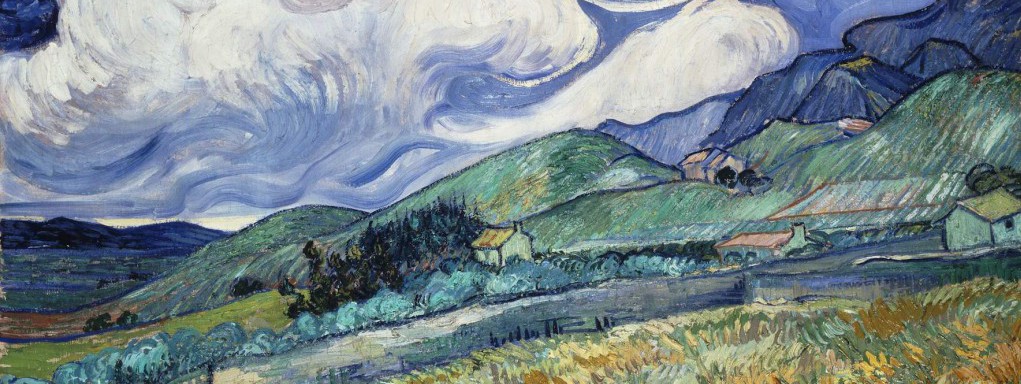
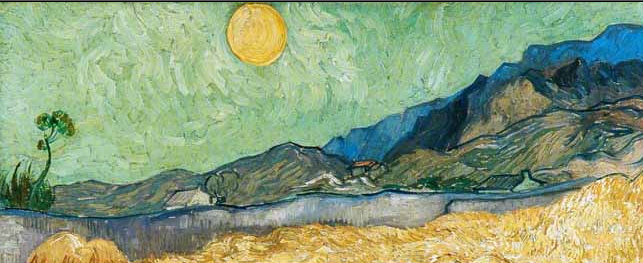
The profile of the hills is quite faithfully rendered, as I was able to see when I found the approximate location where Van Gogh set up his easel (today a field of vines):
 Still for the earthly landscape, let’s move on to the village and its bell tower. One might think that during his outings, Van Gogh had found a place to paint it from life. To do so, Vincent would have had to be on the west side of the city, from where no hill can be seen in the background… Van Gogh’s little village nestled in the hollow of the Alpilles, with its ten or so houses grouped around a church with a needle-shaped steeple (totally unknown in Provence) bears no resemblance to the real village of Saint-Rémy-de-Provence (admittedly more modest at the time than it is today). And the church even less like the collegiate church of Saint-Martin de Saint-Rémy. Van Gogh’s village simply does not exist. Or rather, it is a recomposition made from the memory of certain Dutch villages, a reminiscence of his native land.
Still for the earthly landscape, let’s move on to the village and its bell tower. One might think that during his outings, Van Gogh had found a place to paint it from life. To do so, Vincent would have had to be on the west side of the city, from where no hill can be seen in the background… Van Gogh’s little village nestled in the hollow of the Alpilles, with its ten or so houses grouped around a church with a needle-shaped steeple (totally unknown in Provence) bears no resemblance to the real village of Saint-Rémy-de-Provence (admittedly more modest at the time than it is today). And the church even less like the collegiate church of Saint-Martin de Saint-Rémy. Van Gogh’s village simply does not exist. Or rather, it is a recomposition made from the memory of certain Dutch villages, a reminiscence of his native land.
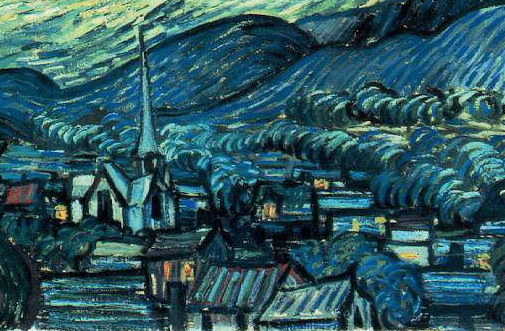 Let us remember the letters of May 23 and June 9 where Van Gogh evokes the landscapes of the Dutch masters Van Goyen and Van Ruysdael, whom he admired and who evoked for him his native land, to which he remained very attached.
Let us remember the letters of May 23 and June 9 where Van Gogh evokes the landscapes of the Dutch masters Van Goyen and Van Ruysdael, whom he admired and who evoked for him his native land, to which he remained very attached.
In the paintings of these two Dutch masters, I found church steeples extraordinarily similar to the one painted by Van Gogh – who had an excellent visual memory.
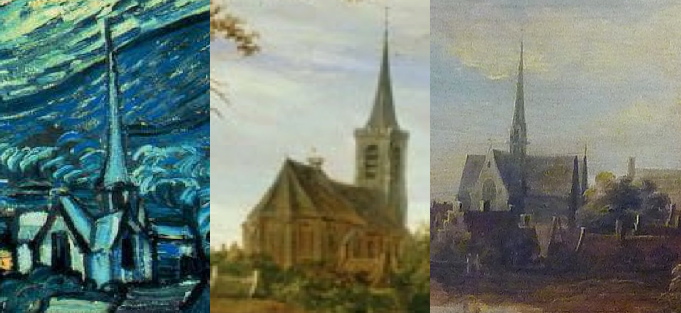
It remains to discuss, in the terrestrial part, the cypress tree, which joins the celestial part. As Vincent wrote to Theo on June 25, 1889 :
« The cypresses still preoccupy me, I’d like to do something with them like the canvases of the sunflowers because it astonishes me that no one has yet done them as I see them.
It’s beautiful as regards lines and proportions, like an Egyptian obelisk.
And the green has such a distinguished quality.
It’s the dark patch in a sun-drenched landscape, but it’s one of the most interesting dark notes, the most difficult to hit off exactly that I can imagine. » [Letter 783]

In addition to being a symbol of Provence, the cypress tree, because of its omnipresence in cemeteries, is a powerful symbol of death. According to some exegesis, its point directed towards the sky would evoke the letter to Theo of July 9 or 10, 1888:
« The sight of the stars always makes me dream in as simple a way as the black spots on the map, representing towns and villages, make me dream.
Why, I say to myself, should the spots of light in the firmament be less accessible to us than the black spots on the map of France.
Just as we take the train to go to Tarascon or Rouen, we take death to go to a star. What’s certainly true in this argument is that while alive, we cannot go to a star, any more than once dead we’d be able to take the train. » [Letter 638]
As Philippe André wrote to me, however, we should perhaps not be satisfied with such a simple formula. This is not Böcklin’s “Island of the Dead” lined with cypress trees. Death, for Vincent at that moment and probably until the end, is only a transformation within a great whole, a change of lifestyle. The cypress is above all a link, the symbol (in its first Greek meaning) between life and death, but also between earth and sky, between down and up, between past (the village of childhood) and present, between the limited and the infinite.
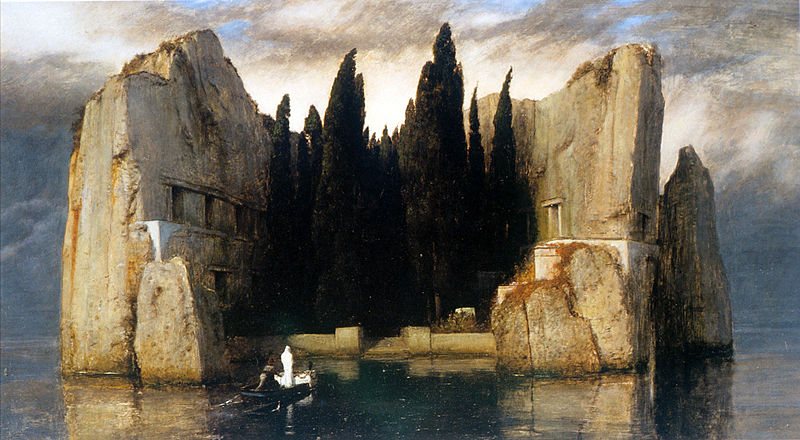
Let us now move on to a new analysis of the celestial landscape, which had occupied me most in my reconstruction of the 1990s, with the proposed date of the beginning of composition being May 25, 1889 at 4:40 am.
On my way to the painting site, I was able to verify that the window of van Gogh’s room, which served as his studio, was facing the east, where the Sun and Venus rise. In my first reconstruction, however, I did not claim that May 25 was the date of the final realization of the painting. Let us remember that it was only in the first week of June that he had received the colors and brushes sent by his brother Theo. And from his letter of July 2 we learn that he was still working on his canvas. The probable scenario is the following: Vincent, subject to insomnia (he will refer to it in his letters), makes a sketch of the starry sky as it appears to him on May 25 at almost five in the morning. Dawn is about to break, as he would later suggest by the clear strokes that form a stream in the sky just above the horizon. In any case, other times Vincent will admire this spectacle of the « shepherd’s star » through the bars of his window at daybreak (letter of June 6). The precision of his drawing is surprising but plausible. Vincent worked in his early days, and up to a year before, with a perspectival frame in an effort to be precise. He executed hundreds and hundreds of drawings. He knows how to do it. Two or three weeks later, he began to paint, in his studio in the asylum, his Starry Night.
It remains to be discussed whether the whirlpool in the center of the painting is a reproduction of an astronomical image – either the Hound Nebula M51 or the Ghost Nebula M74 – that Van Gogh saw in a popular science magazine of the time or in reading Camille Flammarion. In a sense, the hypothesis is too good to ignore. To support it, let us examine the curious representation of the crescent Moon in the drawing that Van Gogh sent to Theo on July 2 : with its horns almost touching, it is not really realistic. However, we find exactly the same type of representation in Camille Flammarion, in an illustration of his 1884 book Les Terres du Ciel.

Against this hypothesis, however, the fact that there is no mention of Flammarion or any popular astronomy book or magazine in Van Gogh’s correspondence from September 29, 1872 to July 31, 1890 is problematic. There are certainly numerous references to the stars, but generally in a rather mystical, not astronomical, sense. Moreover, Vincent always shared with his brother all his knowledge, discoveries, readings and detailed sources for his paintings (in several of his letters he mentions for example Michelet, Emile Zola, Victor Hugo, Shakespeare, etc.). Here, not a word, which would be more than surprising if the astronomical hypothesis were valid. It’s hard to imagine that he was silent on this when he told his brother about his painting. And above all, as Philippe André wisely pointed out to me, the great scroll that animates his sky presents an unmistakable analogy with the shape he gives to the clouds in several of his paintings, such as Wheat Field after the Storm (already mentioned for the depiction of the same profile of hills), Wheat Field with Cypresses shown above (same tormented sky with the same hills and the same cypresses), or Olive Trees with the Alpilles Mountains in the background, all of them dated June-July 1889 !

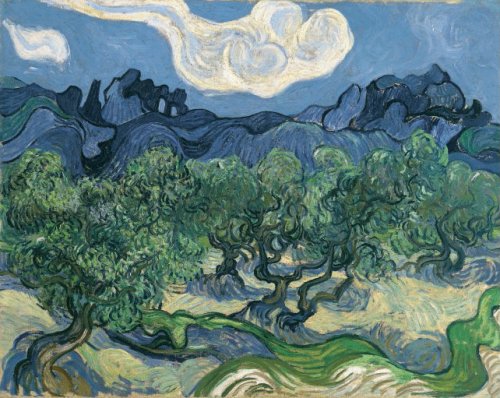
To conclude this long investigation, let us recapitulate with the help of Philippe André :
Starry Night is a composite and partly imaginary painting, like a dream figure, with essentially four symbol-laden elements involved in its composition:
– the stars seen probably for the first time on May 25 at 4:40 am
– the large volute which animates the sky, probable representation of clouds, less probably of a spiral nebula
– the idealized village with its pointed bell tower placed in the place of the wheat field of the asylum, in reference to the landscapes of Dutch masters like van Goyen and van Ruysdael, which evokes his native land
– The cypress tree, totally Provençal, symbol of the night even in the middle of the day, whose shape we find as he sees it on other canvases painted at the same time.
In my post devoted to the Starry Night over the Rhone, I had shown that Van Gogh was already familiar with this kind of montage. In any case, this masterpiece that is the Starry Night at St Rémy translates an admirable and triple conjunction between precise observation, imagination and memory.
A masterpiece considered as such today, but which in its time was hardly appreciated, starting with its own author. Vincent sent his finished painting to his brother Theo in September 1889 along with a few others, calling it simply « night study » or « night effect ». Theo, for his part, called it « The Village in the Moonlight », and in a letter he wrote to Vincent on October 22, 1889 he diplomatically gave a very mixed opinion:
« The Independents’ exhibition is finished and I have your irises back; it’s one of your good things. I consider that you’re strongest when you’re doing real things, like that, or like the Tarascon diligence, or the child’s head, or the upright undergrowth with the ivy. The form is so well defined and the whole is full of colour. I clearly sense what preoccupies you in the new canvases like the village in the moonlight or the mountains, but I feel that the search for style takes away the real sentiment of things. » [Letter 813]
Vincent seemed to accept Theo’s criticism. In a letter of November 3 he replied:
« I know very well that the studies drawn with long, sinuous lines from the last consignment weren’t what they ought to become, however I dare urge you to believe that in landscapes one will continue to mass things by means of a drawing style that seeks to express the entanglement of the masses. […] You’ll see that there’s already more character in a large landscape with pines, red ochre trunks defined by a black line than in the previous ones. » [Letter 816]
And in a letter of November 26 to Emile Bernard he added:
« However, once again I’m allowing myself to do stars too big, etc., new setback, and I’ve enough of that. » [Letter 822]
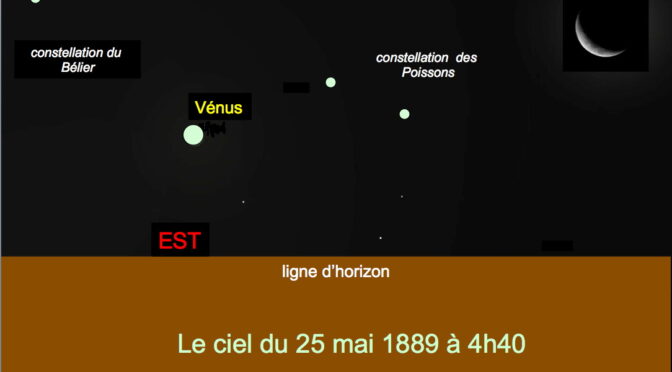

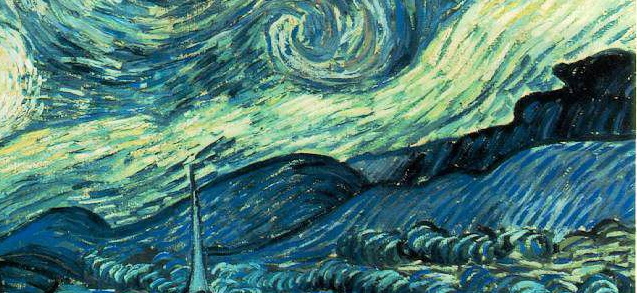
Bonjour, Dans ma jeunesse, je l’avais choisi comme peintre d’étude. À part vous, on se demande qui peut saisir la profondeur de l’être de ce monsieur mis à part le fait de sa notoriété d’aujourd’hui, mais pour les vraies choses. En premier, un peintre joue avec les couleurs. On peut croire qu’il y avait entre lui et la nature, une intimité inexplicable. Aujourd’hui, un moment privilégié pour vous lire et dans l’attente patiente de s’éveiller à quelque chose dont on ne sait pas.